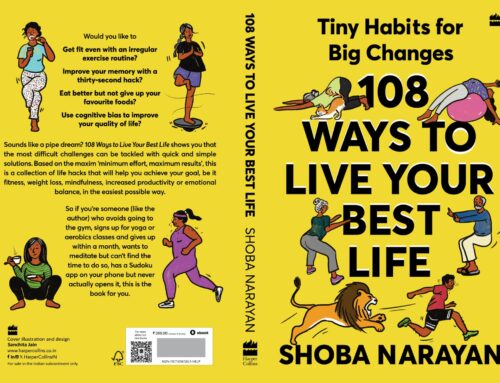A riff on one of my favourite writers, Gerald Durrell and his book, “My family and other animals.”
When Jamal Shaikh commissioned photographer, Prabhat Shetty to shoot these photos for Brunch, what I didn’t know was how process-oriented it would be to appear natural and smiling in photos. I had to cock my head, hold my legs just so then loosen the body. Whew! How do these much-photographed folks do it?
How to buy a cow in India and other stories…
Shoba Narayan’s new book milks her experiences for fodder
BRUNCH Updated: Mar 24, 2018 23:03 IST
Hindustan Times
Author and HT Brunch columnist Shoba Narayan’s living room is dotted with family photos. There are framed photos of parents and kids; some even chronicle important life events. But one photograph stands out: it is of a herd of spotted cows crossing a street. A simple image, it doesn’t quite tell you where it has been shot, only that these cows are focusing their energies on making it to the other side. Shoba is quick to clear the air though; her latest book, The Cows of Bangalore: And How I Came to Own One, is just out, but the cows adorning her living room wall have nothing to do with the book. “This picture was shot in New Zealand more than a decade ago, in the early years of my marriage. This was long before I even thought of writing this book,” she says.
That said, she concedes that with her latest book, life has, in a manner of speaking, come full circle. The Cows of Bangalore belongs to the memoir genre, one that Shoba — with titles such as Monsoon Diary: A Memoir withRecipes and Return to India to her credit — is only too familiar with. But why write a book about cows? Shoba admits that milk lady Sarala and their search for a cow was something that fascinated her right from the early days. “This is also why I wrote an eight-part series on my cow buying experience for HT Mint. The book is an afterthought; it’s unlike my other books which were more planned works.”
Holy cow
Set over the last decade when Shoba moved back with her family to Bengaluru from New York, the book offers a mildly exaggerated account of how Sarala approached her to buy a cow and the resulting search for a ‘good cow’. This is accompanied by enriching nuggets about cows in Indian mythology, the domestication of cows in India and the desi versus hybrid cow debate.
The book is about — and owes its existence to — the generosity of spirit and the eloquence of its protagonist
“The idea was to infuse some humour into the story using an immigrant’s perspective and at the same time, draw attention to the serious fact that desi cow breeds in our country are dwindling,” she points out,emphasising that it was a conscious decision to steer clear from politicising the story.
A challenge no doubt, given how easy it would be to grab attention by putting a political spin on this. “True, but that would entail writing about cow killings and Hindutva politics, which would be digressing from what I set out to write. At the end of the day, the book is about — and owes its existence to — the generosity of spirit and the eloquence of its protagonist Sarala,” Shoba shoots back.
Of fond ruminations
One of Shoba’s favourite recollections in the book is when Sarala and she would enter the army enclave right across the street and shoot the breeze. “This would be sometime in the evening, after she had milked the cows. We’d catch the sun setting as the birds chirped and she’d spot some greens in the complex and rattle on about how one could cook them. It was moments like these that made writing the book totally worth it,” she recounts.
Another riveting fact in the book is the absolute lack of paperwork involved in the buying and selling of a cow. “There’s zero paperwork, can you believe it? Reddy, who sold us the cow Anand Lakshmi, took Rs 75,000 in cash and just loaded her onto the truck. That was it — quite hilarious now that I think about it,” laughs Shoba.
Views for thought
Shoba’s column for HT Brunch, ‘This Indian Life’, is her take on relationships. “My mother-in-law lives with me; plus a lot of my relatives live in the vicinity. This has made me a proxy daughter for several aunts and uncles. The column then is about what it means to be sandwiched between two generations — of one’s parents (elders) and kids,” she explains.
At a time when nuclear families are becoming more common than ever, hers is a column aimed at throwing light on, among other things, the great Indian joint family. “For instance, one of the benefits of living around elders is that you may be exposed to different — and even irksome — perspectives, but they nevertheless help you stop taking yourself so seriously. I think it is imperative to encourage conversation about this topic as it is highly relevant today, especially for our youngsters,” says Shoba.







Leave A Comment